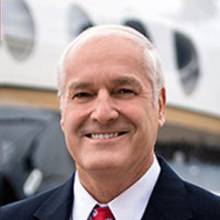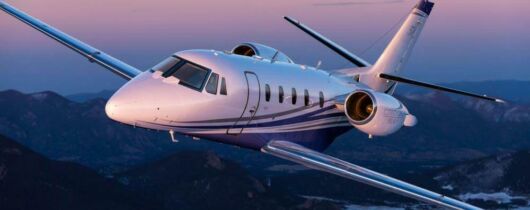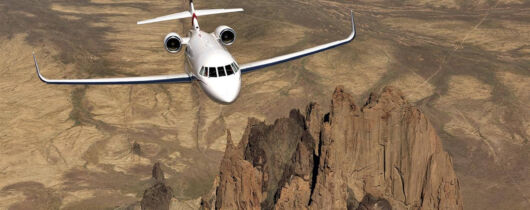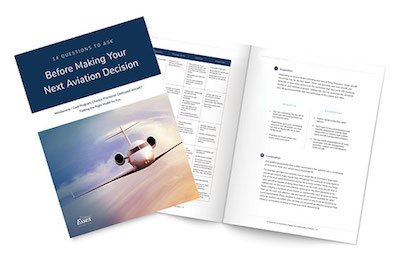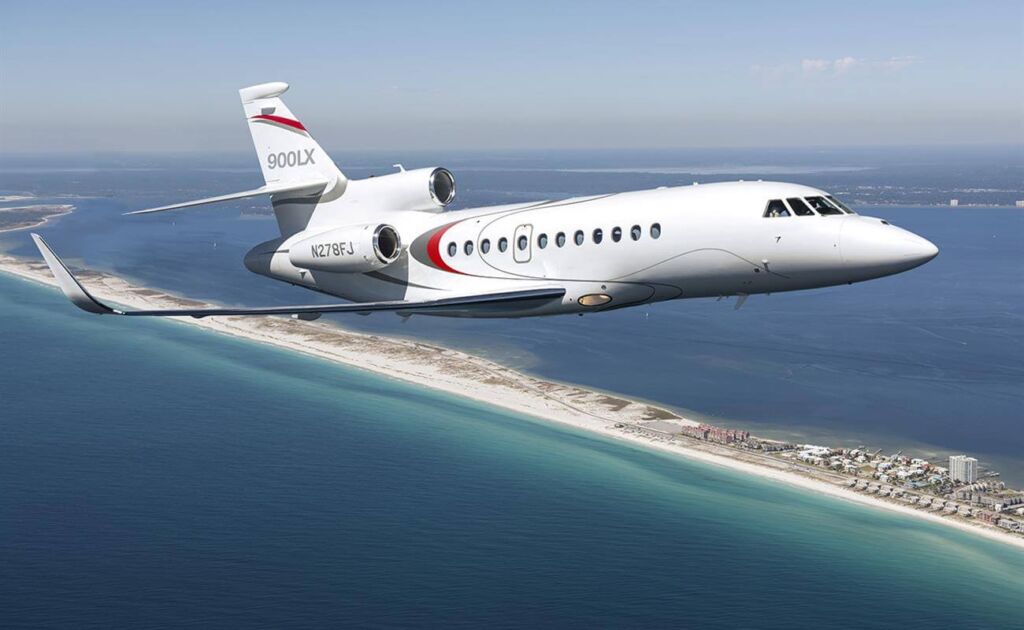
Anyone considering acquiring or chartering a private jet needs to weigh the importance of multiple factors, including the aircraft’s size, model, age, amenities and prior maintenance, among others. The aircraft’s maximum flight range is a critical consideration, especially for individuals who frequently travel long distances.
An aircraft’s range is the maximum distance it can travel — using industry standard safety margins — without stopping for fuel. Aircraft manufacturers use maximum range as a selling point, but it’s important to recognize that cargo, weather conditions and the number of passengers will likely affect that range. In this article, we discuss these and other variables and compare the maximum ranges of popular aircraft models.
Private Jet Range Variables
Why is maximum jet range important?
If an aircraft can accommodate your travel needs by reaching your final destinations “non-stop” or with fewer stops, not only is your travel time shorter and more efficient, but your operating costs are also lower. Landing and take-off operations incur higher fuel consumption as well as adding to the aircraft’s general wear and tear, so minimizing re-fueling stops will reduce the overall cost of the journey.
Range capabilities are typically a significant factor in selecting a private aircraft, but it is important to understand what could influence the aircraft’s actual range — and know those variables up front. Of course, many of these variables will be unknown until the actual day of travel.
Perhaps the most obvious unpredictable variable that will affect an aircraft’s range is the presence of headwinds or tailwinds, which can serve as a boost or impediment to the aircraft’s ground speed. The unique environmental and physical characteristics of airports (both departure and arrival) should also be factored into range calculations. These variables include:
- Local temperature
- Runway length
- Runway condition (wet or dry)
- Elevation of the airport
It is important to recognize that the manufacturer’s stated range anticipates an operator to account for any unique factors, and their estimates are based on average assumptions. Ranges featured in brochures likely assume nominal or even ideal flight conditions; for example, the published range may assume clear weather, fewer passengers and minimal luggage, allowing for maximum fuel capacity.
Additional installed equipment can also adjust the aircraft’s available payload, which, along with the number of passengers, baggage, etc., may influence the allowable weight in fuel and therefore supersede the assumed maximum range published in sales brochures.
Flight Ranges of Common Travel Routes
Ultra long-range aircraft are naturally designed to maximize distance without fuel stops, typically achieving from 6,000 nm to well over 7,000 nm. The table below illustrates sample long range distances that are often requested by those seeking an ultra long-range jet. Note that, in calculating required range for an aircraft, air traffic control (ATC) and weather can influence flight plan routing and therefore the actual point-to-point distances traveled.
| Origination | Destination | Distance (nm) |
| New York | Los Angeles | 2,150 nm |
| New York | London | 3,016 nm |
| London | Dubai | 4,240 nm |
| New York | Tokyo | 5,160 nm |
| Los Angeles | Hong Kong | 6,307 nm |
| Los Angeles | Sydney | 6,512 nm |
| New York | Cape Town | 6,784 nm |
| Chicago | Bangkok | 7,439 nm |
While the range performance of ultra long-range jets is impressive, potential buyers should consider the frequency with which they truly need that capability and ensure whether their unique travel circumstances and expectations will be realized by the particular model private aircraft they are considering.
Aircraft designed for exceptional range are large cabin jets, usually top of the line. These aircraft will normally generate higher expenses associated with both fixed costs — such as crew recruitment, pilot training, insurance and hangar storage — as well as higher variable hourly costs, such as fuel and maintenance.
As a general rule, an ideal aircraft would efficiently accommodate around 85% of your travel needs. Purchasing an aircraft that falls short of that objective can be disappointing, while choosing an aircraft that overperforms can result in higher than desired operating costs for the majority of your travel.
Your home base and frequent destinations are naturally primary factors for decision making. For example, a Dallas-based owner who normally flies domestically has the luxury of choosing from many aircraft models that can easily reach either Los Angeles or New York non-stop. A Boston-based owner who regularly travels to San Francisco, on the other hand, has more limited choices of aircraft that can accommodate non-stop, coast-to-coast flights. The selection of available models narrows even further for owners who regularly travel long international distances.
Private Jet Range Comparison Chart
The guidance in this article truly scratches the surface when it comes to understanding the strengths of certain aircraft models. During the early stages of selection and acquisition, be sure that you fully understand the unique factors that may impact the performance expectations of your preferred aircraft.
The tables below uses an industry published data source estimating range performance samples based on a number of passengers and presumed fuel (weight). The range presented in all categories assumes the aircraft is at its maximum payload for take-off.
| Light Jet | ||||
| Aircraft Model | Manufacturer | Long Range Cruise Speed (kts) | Passengers (at Max Payload) | Range nm (at Max Payload) |
| Phenom 100EV | Embraer | 339 | 3 | 754 |
| CJ3+ | Textron | 352 | 3 | 1123 |
| CJ4 | Textron | 380 | 5 | 1600 |
| Phenom 300E | Embraer | 383 | 7 | 1541 |
| PC-24 | Pilatus | 440 | 4 | 1290 |
| Mid-size Jet | ||||
| Aircraft Model | Manufacturer | Long Range Cruise Speed (kts) | Passengers (at Max Payload) | Range nm (at Max Payload) |
| Citation XLS+ | Textron | 373 | 4 | 1434 |
| Sovereign+ | Textron | 396 | 6 | 2647 |
| Latitude | Textron | 372 | 5 | 2346 |
| Challenger 3500 | Bombardier | 446 | 10 | 2967 |
| Gulfstream 280 | Gulfstream | 458 | 5 | 2886 |
| Falcon 2000LXS | Dassault | 440 | 9 | 3179 |
| Praetor 500 | Embraer | 424 | 8 | 2885 |
| Large Cabin Jet | ||||
| Aircraft Model | Manufacturer | Long Range Cruise Speed (kts) | Passengers (at Max Payload) | Range nm (at Max Payload) |
| 900LX | Dassault | 440 | 8 | 4122 |
| Praetor 600 | Embraer | 433 | 11 | 3433 |
| Global 5500 | Bombardier | 471 | 15 | 4549 |
| G500 | Gulfstream | 488 | 15 | 4921 |
| Challenger 650 | Bombardier | 425 | 7 | 3315 |
| Ultra Long-Range Jet | ||||
| Aircraft Model | Manufacturer | Long Range Cruise Speed (kts) | Passengers (at Max Payload) | Range nm (at Max Payload) |
| Global 6500 | Bombardier | 488 | 14 | 6220 |
| Falcon 8X | Dassault | 459 | 11 | 5800 |
| G600 | Gulfstream | 488 | 13 | 6001 |
| 650ER | Gulfstream | 488 | 7 | 6751 |
| Global 7500 | Bombardier | 479 | 10 | 7203 |
| G700 | Gulfstream | 488 | 11 | 6877 |
Source: Conklin & de Decker
When selecting either a new or pre-owned aircraft, it is wise to speak with an aviation consultant to confirm that the non-stop range of your preferred model can meet your travel objectives. An expert in private jet capabilities — such as those at Essex Aviation — can answer questions pertaining to your intended destinations, passenger and luggage needs, budget and more to help you make the most of your aircraft acquisition or charter.



